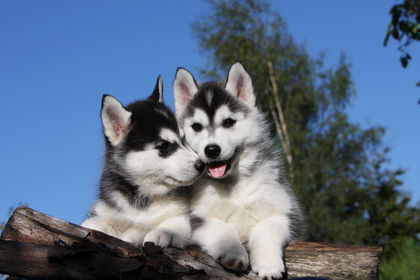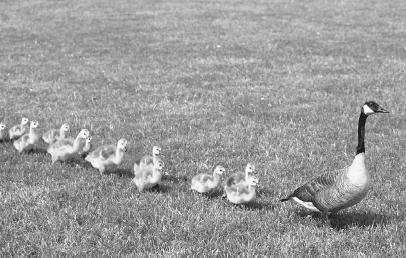Instinct and Learning - How it works

Instinct
The founding fathers of ethology (the study of animal behavior, including its mechanisms and evolution) were the German zoologist Konrad Lorenz (1903-1989) and the Dutch ethologist Nikolaas Tinbergen (1907-1988). In addition to their separate contributions to the field, which we discuss later, the two scientists together developed a theory that animals employ formalized, rigid sequences of action in response to specific stimuli. These sequences they called fixed-action patterns of behavior, or FAPs.
In studying male stickleback fish, Tinbergen discovered an excellent example of a FAP. Males of that species recognize potential competitors, in the form of other stickleback males capable of breeding, by the red stripe on their underside. Tinbergen termed the red stripe a behavioral releaser, or a simple stimulus that brings about a FAP. (A stimulus is any observable fact or event that directly influences the activity or growth of a living organism.)
This particular FAP compels the male stickleback to attack anything red, even when it is not a competitor. Thus, as Tinbergen observed, jealous stickleback males actually would try to attack red British mail trucks when they could see them through the glass of their tanks. Clearly, then, a FAP such as the response to the red stripe is not something that an animal thinks through; rather, it is automatic, almost as though the animal were being acted upon, instead of acting in its own right.
There have been stories and scientific studies of animals seemingly acting above and beyond the call of duty by raising the offspring of other individuals—even those of another species. Tin-bergen, for example, observed and photographed a cardinal feeding baby minnows at water's edge. Such behavior seems altruistic, touching, and even inspiring, yet for all the significance we might be inclined to place on it from our human perspective, it is nothing but a FAP. Most likely the bird had lost its own offspring, and was simply acting on a parental instinct, which caused it to respond to the sight of open, upturned, hungry mouths. It so happened that the open mouths were not those of its offspring at all, but of fish, yet this made no difference in the behavior of the cardinal, acting as it was on an inborn, stereotypic pattern of response.
SURVIVAL-FRIENDLY, CONTROLLED BEHAVIOR.
This is one characteristic of instinct, a concept virtually synonymous with that of the FAP: the creature acting on instinct is not thinking about what it does but is behaving almost as though it were controlled by some outside force. The use of the "outside force" concept perhaps makes instinct sound like something mystical when it is not. On the contrary, instinctive behavior is simply a survival mechanism in the brains of each member of a particular species, developed through countless generations of natural selection.
If a particular behavior helps foster the survival of a species, natural selection favors it. In other words, those individuals of a species who possess the tendency toward a particular survival-friendly behavior are the ones that survive and pass on their genes to others, while those that do not possess this tendency do not. The survival-friendly instinct may be geared toward the survival of the individual, its offspring, or others.
Closely tied to instinct is the innate animal behavior known as a reflex : a simple, inborn, automatic response to a stimulus by a part of an organism's body. Reflexes help animals (including humans) respond quickly to a stimulus, thus protecting them from harm. Again, the animal does not think about what it is doing. If you touch a hot stove or receive an electric shock, you do not decide to pull your hand back: you whip your hand away from the painful stimulus faster than you can blink. As with instinct, a reflex is a survival-friendly behavior over which the animal (in this case, you) has little control.
Innate Versus Learned Behavior
Instinct is innate, meaning that instinctive behaviors and responses are present and complete within the individual at birth. In other words, the individual does not have to undergo any experience to acquire such behaviors. For example, fish have an innate ability to swim, whereas most mammals must learn how to walk. It is fairly easy to identify innate behavior when an animal exhibits it at birth, but in some cases innate behavior manifests only later in life.
In such situations improvements in the creatures' ability to perform an innate behavior may seem to indicate that the animal is learning, when, in fact, another process is at work. For example, chickens exhibit the innate tendency toward pecking as a way of establishing and maintaining a dominance hierarchy. This is the "pecking order," to which people often refer in everyday speech as a metaphor for various hierarchies in human experience, such as those at a workplace. Though pecking is innate, chickens' ability to perform it actually improves as they grow older.
Older chickens display a better aim when pecking than do younger ones, but this does not mean that they have learned from experience. Indeed, one clue that pecking is innate in older chickens is the fact that they uniformly improve in their ability to peck. On the other hand, if they were simply learning, with practice, how to peck more accurately, one could expect that some chickens would exhibit more dramatic improvement than others, in the same way that some humans play basketball (or sing or write poetry) better than others. In fact, what has happened is that the ability to perform an innate behavior simply has improved as a result of growth: as the chickens' eyes and muscles mature, their aim improves, but this has nothing to do with experience per se.
Imprinting
This is one example of the ways in which instinctive and learned behavior can become confused, though in the pecking example there is really no gray area; rather, what is actually an innate behavior merely seems to be a learned one. Yet there truly is a great deal of gray area between instinct and learning. Many behaviors that at first glance might appear purely instinctive can be shown to have an experiential component—that is, an aspect of the behavior has been modified through experience or learning.
A fascinating example of how instinct and learning can be blurred or combined is imprinting, or the learning of a behavior at a critical period early in life, such that the behavior becomes permanent. Lorenz, who first developed the theory of imprinting, noted that newly hatched geese learn to walk by following their parents, but he wondered how they distinguished their parents from all other objects in their environments.

From these experiments, Lorenz concluded two things. First of all, during a critical period following birth, goslings follow their parents' movements and learn enough about their parents to recognize them. This critical period is short: if he walked in front of three-day old geese, they were already too old to imprint on him. Second, Lorenz determined that the parents' movement must be a behavioral releaser for imprinting; thus, if the tiny goslings happened to fix on another moving object, they would imprint on that one.
We can see in this example that imprinting has both innnate, or instinctive, and learned components. The tendency to imprint is innate, but if the act of imprinting itself were likewise innate, then it would be the same for all individuals within a species, and this is not the case. The vast majority of goslings will imprint on adult geese, of course, but in an experimental setting (or through some freak accident in nature), it is possible that some other object will come between the offspring and its parents, causing the offspring to imprint on it.
Once imprinting is complete, it brings about numerous consequences that are more or less automatic or inevitable. Yet for all their automatic, inevitable qualities, these consequences are not the result of innate behaviors or instincts but of learned behaviors. Thus, learning is destiny, at least to an extent. The individual's mind, at an early stage, is like wet concrete into which virtually any impression can be made. Once the individual has imprinted on something or someone, however, the concrete begins to set, and it hardens around the impressions made in it.
Comment about this article, ask questions, or add new information about this topic: